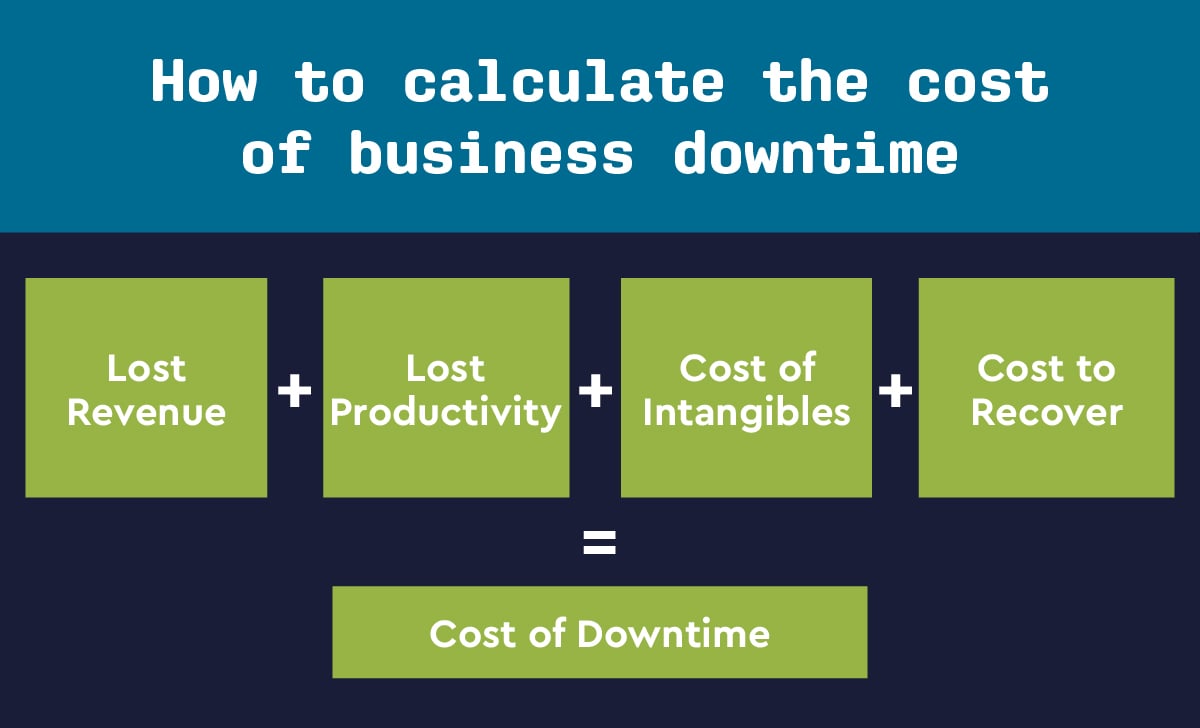Business downtime can have devastating consequences. Even a small period of downtime can cause a loss of productivity, revenue, and customer satisfaction. Surveys indicate that server business downtime costs range from $301,000 to $400,000 per hour, with infrastructure failures costing larger enterprises around $100,000 per hour.
You know how crucial it is to ensure uninterrupted operation and smooth functioning of your clients' IT systems. Robust disaster recovery and business continuity planning is key to avoid any potential business downtime.
By implementing regular data backups, redundant systems, proactive monitoring, and rapid incident response, you can protect your client's IT infrastructure, reduce costs, and maximize protection.
In order to minimize such risks and ensure uninterrupted continuity, we've collected essential tips for you to keep in mind. Follow these recommendations, and you can protect your clients' businesses and keep them running smoothly even during unexpected events.
Common causes of business downtime
Business downtime can stem from a variety of causes, each with implications for your clients and their customers. Understanding these causes is essential to address and mitigate the risk of downtime proactively.
The following are some of the most common causes and their effects:
Human error
A single mistake or human error, whether accidental or due to negligence, can disrupt critical systems and result in costly downtime. This leads to immediate loss of productivity, revenue, and potential damage to the organization's reputation.
You can help mitigate the impact of human error by holding frequent training sessions to inform staff of excellent practices and implementing well-documented IT checklists and policies to reduce the occurrence of errors.
Example:
In January of 2023, airline departures across the US were temporarily suspended due to human error. The Federal Aviation Administration (FAA) revealed that the glitch occurred because a contractor mistakenly deleted files, causing damage to a database file. This incident resulted in flight cancellations and delays nationwide, as pilots were unable to access the system providing critical flight information.
Since the event, the FAA has conducted repairs and implemented measures to enhance the resilience of the affected system. However, due to this incident and previous aviation issues during the prior Christmas holiday, the agency was put under heavy criticism and scrutiny from the general public and government.
Malicious sabotage
Businesses are at risk from malicious sabotage, including vandalism and insider threats. These attacks can damage IT infrastructure, compromise data, or manipulate systems. Malicious sabotage can cause extended system downtime, compromised data integrity, and reputational damage.
You need to implement robust security measures to protect against such attacks. Implement strict access controls, conduct employee background checks, and monitor systems constantly for suspicious activity.
Example:
Telecom provider T-Mobile suffered a data breach in May of 2023. According to recent reports, hackers were able to access PIN-protected accounts in order to scrape data like contact information, ID cards, and even social security numbers. While this smaller breach only affected 800 customers, it comes on the heels of several other prominent breaches in January of 2023, November of 2022, and December of 2021. In total, hundreds of millions of T-Mobile customers have had their data compromised between these attacks.
After the 2021 attack, the company pledged to invest $150 million into security, but the threat of sabotage is clearly still present.
Cyberattacks
Besides general downtime, cyberattacks can encrypt or steal sensitive data, disrupt operations, and demand ransoms.
Your teams play a crucial role in mitigating cyberattacks on clients by implementing security solutions, such as endpoint monitoring and ransomware protection. Conducting regular security assessments and educating employees about cybersecurity best practices will help you defend against these attacks.
Example:
The Black Basta ransomware group targeted the American Dental Association in April of 2022, claiming responsibility for a DDoS attack and stealing around 9GB of data, leaking roughly 2.8G of said data online. The leaked data included extremely sensitive information, such as accounting spreadsheets, member information, NDAs, and W2 forms. One notable aspect of this attack is that it was particularly harmful to small dental businesses. Because many of these businesses don’t have dedicated IT teams, they are more likely to not have properly secured networks.
Hardware failure
Hardware failure can occur due to various reasons, such as aging equipment, power surges, or manufacturing defects. When critical hardware components fail, it can result in system crashes, data corruption, and extended downtime.
You can assist clients by implementing proactive monitoring and maintenance practices to identify and address potential hardware issues before they lead to significant disruptions. In addition, regular hardware audits, timely hardware upgrades, and redundancy measures can minimize the impact of hardware failure on business operations.
Example:
Facebook had a hardware failure in one of its data centers in 2021, causing a widespread outage. During routine maintenance, the platform's engineers unintentionally disconnected data centers from the rest of the world. It disrupted services for billions of users and caused negative publicity. Despite deployment of engineers and drills, the outage highlighted the platform's overreliance on its infrastructure and the need for continuous improvement. It was a challenging week for the company, as it faced allegations and a Senate hearing.
Power cuts/natural disasters
Power cuts and natural disasters, including hurricanes, floods, and earthquakes, pose significant risks to business continuity. These events can disrupt a power supply, damage hardware, and disable communication channels, leading to extended downtime.
You can help clients prepare for such events by implementing comprehensive business continuity solutions, which include backup power solutions to ensure uninterrupted operations during power outages, as well as robust data backup and recovery strategies to safeguard critical data in the event of natural disasters or other disruptive incidents.
Example:
Hurricane Ian, which decimated Florida and South Carolina in the US in 2022, was noted as the second-largest insured loss on record, following Hurricane Katrina in 2005. The storm incurred between $50 billion and $65 billion in estimated damages. This number stems not only from physical damage, but widespread power outages that left businesses without electricity for days. Power outages affected business operations, especially for those heavily reliant on technology and online services. Business disruptions lasted for days or even weeks, highlighting the vulnerability of businesses to natural disasters.
Historical costs of prolonged business downtime
Lengthy business downtime can result in significant financial costs, depending on organization size and industry. How much does downtime cost a company?
According to a report from AppDynamics, Fortune 1000 companies can face annual costs of $1.25 billion to $2.5 billion due to unplanned application downtime.
Data from Infrascale adds that for 10% of small and medium-sized businesses (SMBs), downtime costs exceed $50,000 per hour, and for the rest, it ranges from $10,000 to $40,000 per hour.
Through proactive measures and comprehensive disaster recovery planning, you assist businesses of all sizes in mitigating the financial impact of downtime.
How to calculate the cost of business downtime
When discussing the need for a backup and disaster recovery (BDR) plan, it's essential to convey the financial impact of downtime to clients. You can demonstrate the value of investing in business continuity by calculating the cost of downtime using the following factors:
- Lost revenue: Determine revenue per week/month, reliance on uptime, and calculate revenue lost per hour for each area of the business.
- Lost productivity: Assess hourly wages and productivity reliance on uptime and calculate each employee's lost productivity cost.
- Cost to recover: Consider expenses for data recovery, hardware repair/replacement, lost data recovery, and ongoing costs due to data loss.
- Cost of intangibles (reputation cost): Highlight possible reputational implications, such as customer discontent and trust erosion.
To calculate the final cost of downtime, use the formula: Cost of Downtime (per hour) = Lost Revenue + Lost Productivity + Cost to Recover + Cost of Intangibles.

How BCDR solutions help with downtime
Implementing a robust business continuity and disaster recovery (BCDR) solution can significantly minimize downtime and associated business costs. Here's how a BCDR solution can help:
- Rapid recovery: BCDR solutions ensure that businesses can quickly recover from outages and disruptions. By having backups readily available, organizations can restore critical systems and data to minimize downtime and resume normal operations promptly.
- Data protection: BCDR solutions help protect against data loss during unforeseen events. Regular backups and off-site storage in the cloud provide a safety net, ensuring that essential business data is preserved and can be recovered if needed.
- Reduced financial losses: BCDR solutions can help you reduce downtime-related financial losses. By implementing BCDR strategies, you can minimize revenue loss, mitigate productivity decline, recovery expenses, and potential reputation damage. With these solutions, you and their clients can ensure business continuity and limit downtime's financial impact.
- Improved resilience: BCDR planning and preparation improve overall business resilience. By identifying potential risks, conducting business impact analysis (BIA), and implementing BCDR plans, organizations can proactively address vulnerabilities and enhance their ability to withstand disruptions.
Here are some hypothetical scenarios where BCDR specifically will help.
- Natural disasters: Businesses affected by hurricanes, earthquakes, or floods can leverage BCDR solutions to recover quickly. By having data backups in remote locations or cloud environments, these organizations will be able to restore critical systems and resume operations without extensive downtime.
- Ransomware attacks: Companies targeted by ransomware can successfully recover their systems and data using BCDR solutions. With reliable backups, they can restore clean versions of their systems, avoiding the need to pay ransoms or suffer prolonged downtime.
- Hardware failures: Businesses experiencing hardware failures, such as server crashes or storage malfunctions, can minimize downtime with BCDR solutions. By restoring systems from backups, your clients can avoid lengthy recovery processes and keep their operations running smoothly.
Types of BCDR solutions
When choosing a business continuity and disaster recovery (BCDR) solution, several options are available, each with its own characteristics and considerations:
- Server-based backup: Backup data from servers to local appliances or public/private clouds for quick access or off-site storage.
- SaaS backup: Protect data on cloud-based applications like Microsoft 365, Google Workplace, Dynamics 365, and Salesforce with platform-specific backup and recovery capabilities.
- Workstation or laptop backup: Safeguard data on individual workstations or laptops, storing backups in public/private cloud environments.
- Hosted or virtual server backup: Back up virtual servers in public/private cloud environments for businesses utilizing virtualized infrastructure.
When choosing the right BCDR solution, consider factors such as:
- Cloud, software, and hardware elements: Look for solutions supporting virtual assets, SaaS or hosted storage platforms, local servers, and desktops with a combination of cloud, software, and hardware components.
- Cloud backup and recovery: These should have off-site storage capabilities, so data can be stored securely on remote servers when evaluating them. It should also have fail-over operations, so when necessary, data and applications can be switched seamlessly to backup systems.
- Data restoration scenarios: Assess the solution's capability to recover individual files, complete servers, or multiple systems in a time frame that meets your client’s Maximum Tolerable Downtime (MTD).
- Security and compliance: Choose BCDR solutions compliant with industry standards (e.g., SOC 1 / SSAE 16 and SOC 2 Type II) and offering robust security features like two-factor authentication.
By evaluating these factors and understanding your business's needs, you can select an appropriate BCDR solution that aligns with your data protection and disaster recovery goals.
Disasters happen, be prepared
If you’ve been asking yourself, “How does downtime impact my clients’ businesses?” then this article should have helped you see things clearly.
After all, disasters happen unexpectedly. So, it's critical to plan ahead of time and minimize the impact of interruption on your clients.
Make sure you have regular backups, redundant systems, and rapid incident response protocols to minimize the impact of downtime. Business continuity is ensured by prioritizing IT security and preparedness.
Disasters can strike anytime, but being prepared is key. Take action by reviewing clients' BCDR strategies, assessing readiness, and improving. Establish yourself as a trusted partner, protect clients' businesses, and provide peace of mind. Be proactive, prepared, and ready for anything.
Looking for a powerful BCDR solution? Discover the capabilities of ConnectWise Co-Managed or SaaS Backup with our on-demand demo. See how our advanced data verification, continuous data protection, backup monitoring, and instant virtualization can ensure quick and reliable disaster recovery for your clients.













